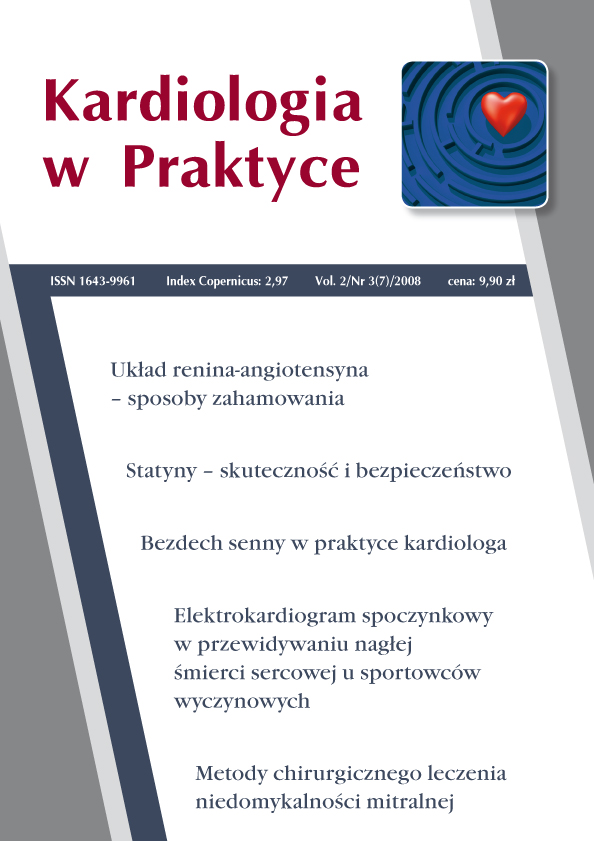Surgical management of mitral regurgitation Review article
Main Article Content
Abstract
Mitral insufficiency is defined as the retrograde blood flow (from the left ventricle to the left atrium) which results from the impaired function of the valve leaflets. The proper function of the mitral valve is related not only to the proper anatomy of the valvular and subvalvular structures but also to their cooperation with the left chambers of the heart. The most common type of chronic mitral regurgitation is rheumatic regurgitation. Mitral disease may be also due to degenerative changes of the mitral apparatus, infective endocarditis or ischemic heart disease. Mitral regurgitation may develop acutely as a result of chordal rupture or infective endocarditis or may may complicate the myocardial infarction. Symptomatic patients with LVEF >35% and ESD <55 mm as well as asymptomatic patients with poor left ventricle function (LVEF ≤60%, ESD >45 mm) are indicated for surgery. There are two surgical strategies on the level of treatment: mitral valve repair or mitral valve replacement. Is has been widely proven that mitral valve sparing operation is more beneficial in comparison to mitral valve replacement. What is the optimal time for mitral valve surgery – the answer to this question seems to be essential. The best results can be expected when we operate patients with left ventricle systolic function maintained.
Downloads
Article Details

This work is licensed under a Creative Commons Attribution-NonCommercial-NoDerivatives 4.0 International License.
Copyright: © Medical Education sp. z o.o. This is an Open Access article distributed under the terms of the Attribution-NonCommercial 4.0 International (CC BY-NC 4.0). License (https://creativecommons.org/licenses/by-nc/4.0/), allowing third parties to copy and redistribute the material in any medium or format and to remix, transform, and build upon the material, provided the original work is properly cited and states its license.
Address reprint requests to: Medical Education, Marcin Kuźma (marcin.kuzma@mededu.pl)
References
2. Guidelines on the management of valvular heart disease. The task force of the management of the valvular heart diseases of the European Society of Cardiology. Eur. Heart J. 2007, 28: 230-268.
3. Yun K.L., Sintek C.F. et al.: Randomized trial comparing partial versus complete chordal–sparing mitral valve replacement effects on left ventricular volume and function. J. Thorac. Cardiovasc. Surg. 2002, 123: 707-714.
4. Kirklin J.W., Barratt-Boyes B.G.: Cardiac Surgery (3d edition). Churchill Livingstone Inc., New York 2003.
5. Lehmann S., Walther T., Mohr F.W.: Mid-term results after stentless mitral valve replacement. Comparison to conventional mitral valve replacement and mitral valve repair. Herz 2007, 32(6): 499-505.
6. Biedermann A.: Postępowanie chirurgiczne w wadzie mitralnej. W: Współczesne postępowanie interwencyjne w wadzie zastawki mitralnej. Rawczyńska-Englert I. (red.). Wydawnictwo Medyczne, 2004.
7. Shuhaiber J., Anderson R. J.: Meta-analysis of clinical outcomes following surgical mitral valve repair or replacement. J. Cardiothorac. Surg. 2007, 31(2): 267-75.
8. Zhao L., Kolm P. et al.: Comparison of recovery after mitral valve repair and replacement. J. Thorac. Cardiovasc. Surg. 2007, 133(5): 1257-63.
9. Feringa H.H., Shaw L. et al.: Mitral valve repair and replacement in endocarditis: a systemic review of literature. Ann. Thorac. Surg. 2007, 83(2): 570-1.

